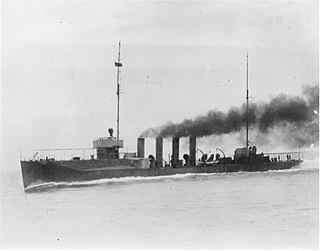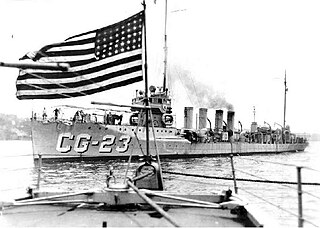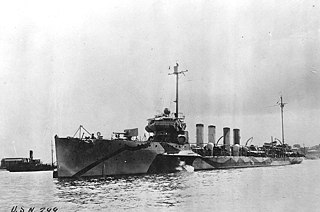
The first USS Cummings (DD-44) was a Cassin-class destroyer used by the United States Navy during World War I. She was later transferred to the United States Coast Guard, where she was designated CG-3. She was named for Lieutenant Commander Andrew Boyd Cummings.

USS Terry (DD-25) was a modified Paulding-class destroyer in the United States Navy during World War I, and later in the United States Coast Guard, designated CG-19. She was the first ship named for Edward A. Terry, and the first ship commanded by future Fleet Admiral and Chief of Naval Operations Ernest J. King.

USS McCall (DD-28) was a Paulding-class destroyer in the United States Navy during World War I and later in the United States Coast Guard, designated CG-14. She was the first ship named for Edward McCall.

USS Burrows (DD-29) was a modified Paulding-class destroyer in the United States Navy during World War I and later in the United States Coast Guard, designated (CG-10). She was the second ship named for Lieutenant William Ward Burrows II.

The first USS Monaghan (DD-32) was a modified Paulding-class destroyer in the United States Navy during World War I and later in the United States Coast Guard, designated (CG-15). She was named for Ensign John R. Monaghan.

The second USS Trippe (DD-33) was a Paulding-class destroyer in commission in the United States Navy from 1911 to 1919. She was named for Lieutenant John Trippe. She saw service during World War I.

The first USS Ammen (DD-35) was a Paulding-class destroyer in the United States Navy during World War I and later in the United States Coast Guard, designated as CG-8. She was named for Rear Admiral Daniel Ammen.

The first USS Patterson (DD-36) was a modified Paulding-class destroyer in the United States Navy during World War I and later in the United States Coast Guard, designated as CG-16. She was named for Daniel Patterson.

The first USS Fanning (DD-37) was a modified Paulding-class destroyer in the United States Navy during World War I and later in the United States Coast Guard, designated as CG-11. Her namesake was Nathaniel Fanning.

The first USS Henley (DD-39) was a modified Paulding-class destroyer in the United States Navy during World War I and later in the United States Coast Guard, designated as CG-12. She was named for Robert Henley.

The first USS Jouett (DD-41) was a modified Paulding-class destroyer in the United States Navy during World War I and later in the United States Coast Guard, designated as CG-13. She was named for Rear admiral James Edward Jouett.

The O'Brien class of destroyers was a class of six ships designed by and built for the United States Navy shortly before the United States entered World War I. The O'Brien class was the third of five classes of destroyers that were known as the "thousand tonners", because they were the first U.S. destroyers over 1,000 long tons (1,016 t) displacement.

USS Ericsson was an O'Brien-class destroyer built for the United States Navy prior to the American entry into World War I. The ship was the second U.S. Navy vessel named in honor of John Ericsson, the Swedish-born builder of the ironclad warship USS Monitor during the American Civil War.

USS Tucker was the lead ship of her class of destroyers built for the United States Navy prior to the American entry into World War I. The ship was the first U.S. Navy vessel named for Samuel Tucker.

The Tucker class of destroyers was a ship class of six ships designed by and built for the United States Navy shortly before the United States entered World War I. The Tucker class was the fourth of five classes of destroyers that were known as the "thousand tonners", because they were the first U.S. destroyers over 1,000 long tons (1,016 t) displacement.

USS Conyngham was a Tucker-class destroyer built for the United States Navy prior to the American entry into World War I. The ship was the first U.S. Navy vessel named for Gustavus Conyngham.

USS Porter was a Tucker-class destroyer built for the United States Navy prior to the American entry into World War I. The ship was the second U.S. Navy vessel named in honor of both David Porter and his son David Dixon Porter.

USS Davis (DD-65) was a Sampson-class destroyer in commission in the United States Navy from 1916 to 1922. She saw service during World War I. She was the second Navy ship named for Rear Admiral Charles Henry Davis (1807–1877).

HMS L2 was a L-class submarine built for the Royal Navy during World War I.

United States Navy operations during World War I began on April 6, 1917, after the formal declaration of war on the German Empire. The American navy focused on countering enemy U-boats in the Atlantic Ocean and the Mediterranean Sea while convoying men and supplies to France and Italy. Because of United States's late entry into the war, her capital ships never engaged the German fleet and few decisive submarine actions occurred.





















